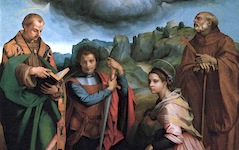Andrea Del Sarto’s St John the Baptist (c.1523)
Visiting the Palazzo Pitti in Florence to see their wonderful collection of works by Raphael and Andrea del Sarto, a lesser-known but still major figure of the High Renaissance, I was struck by how I saw Raphael's initial, the letter R, appear metamorphically in so many of his images, most still unpublished. I wondered whether works by Andrea del Sarto, a contemporary of Raphael, did too. He was born in Florence as Andrea d'Agnolo di Francesco di Luca di Paolo del Migliorea but was later known simply as Andrea del Sarto because he was a tailor's son and sarto means tailor. The name he used was Andrea.

Andrea del Sarto, St. John the Baptist (c. 1523) Oil on wood. Palazzo Pitti, Florence.
Click image to enlarge.
The first of his paintings I came across confirmed not only that he did use the letter A in his painting but that he identified, like Raphael and so many other artists, with Christ as well.1
The first step, as always, is to consider whether the subject has any facial resemblance to the artist and, in this case, we are hindered by no accepted self-portrait by Del Sarto as a young man. We have to use one from the last years of his short life. He died aged 44.
Click next thumbnail to continue

L: Detail of Del Sarto's St. John the Baptist
R: Detail of Del Sarto's Self-portrait (c.1529) inverted
Click image to enlarge.
Many of his figures have similar faces, however, and there seems to be a rough resemblance here, if difficult to pinpoint on account of the age difference. Note that their eyes slant downwards to the right though their heads are straight and that the Baptist's hair crosses his forehead along the same diagonal as the artist's cap.
Click next thumbnail to continue

Top L: Detail of Del Sarto's St. John the Baptist (c.1523)
Top R and Lower L: Detail of Del Sarto's Portrait of Lucrezia di Baccio del Fede (1513-14)
Lower R: Detail of Del Sarto's Self-portrait (c.1529) inverted
Click image to enlarge.
St. John (top left) perhaps bears more resemblance to Andrea's portrait of his wife (top right). That would not be surprising given his wife is also said to have modelled for his Madonnas. That belief, though, is the result of a misunderstanding. His wife's face, like that of many artist's wives and mistresses in their portraits, is actually a fusion of his features with hers (lower images). That means all these painted figures - Virgins, wife and Baptist - probably resemble Andrea.
Click next thumbnail to continue
Then, searching the composition, I came across the twig tying the two arms of the Baptist's Cross. It forms the letter A for Andrea, signing the cross as his own. Andrea is Christ too, a common experience in mystical and esoteric Christianity featured in the art of at least seven centuries. The goal of this tradition is to follow the example of Christ and the saints and so purify your mind that you lose your ego-self and let your divine essence shine through. At that moment you are said to be at one with Christ and God.
Click next thumbnail to continue
Now we can recognize that John holds the bowl of water (for baptising) like an artist's palette while the fur just above it suggests the hairs of a paintbrush. His other arm, holding the chalice, a symbol of spiritual purity, is poised at the edge of the canvas where an artist's brush-hand is often positioned when using a mirror to help paint a self-portrait. His "easel" would be just out-of-frame to the right. As so often in art, the entire surface of this image is a reflection in the mirror of the artist's divinely-inspired mind. We, viewers, now stand where the artist once did in front of his "mirror". He intends to help those who can see. By interpreting it ourselves we recognize that our minds too are both creative and divine. In today's secular world identification with God suggests identification with the creative powers of nature and a conscious sense of unity with the universe. There is, as they say, star-dust in all of us.
See note below.
N.B. See entry on Andrea Del Sarto's Madonna in Gloria (1530) for the use of his initial A in a different context.
More Works by Del Sarto
Notes:
1. For other artists identifying with Christ through mystical and esoteric Christianity, see the many examples under the theme Artist as Christ, listed in the left column under Alter Ego+. They include, as of this date, artists as diverse as Giovanni Bellini, Botticelli, Cézanne, Lucas Cranach the Elder, Albrecht Durer, Jean Fouquet, Hendrick Goltzius, Goya, Leonardo, Roy Lichtenstein, Lucas van Leyden, Manet, Mantegna, Michelangelo etc. etc.
For artists using their initials in similar ways, see even more examples under the theme Letters in Art, listed in the left column under Poetic Mind+.
Original Publication Date on EPPH: 05 Oct 2013. © Simon Abrahams. Articles on this site are the copyright of Simon Abrahams. To use copyrighted material in print or other media for purposes beyond 'fair use', you must obtain permission from the copyright owner. Websites may link to this page without permission (please do) but may not reproduce the material on their own site without crediting Simon Abrahams and EPPH.


